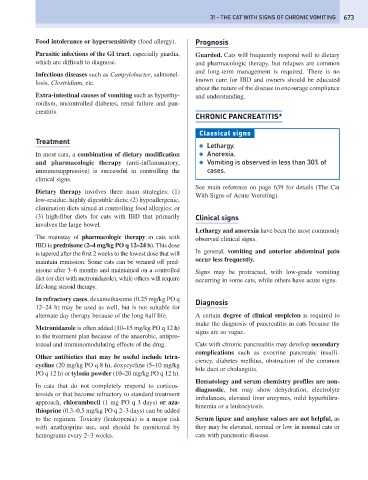Page 681 - Problem-Based Feline Medicine
P. 681
31 – THE CAT WITH SIGNS OF CHRONIC VOMITING 673
Food intolerance or hypersensitivity (food allergy). Prognosis
Parasitic infections of the GI tract, especially giardia, Guarded. Cats will frequently respond well to dietary
which are difficult to diagnose. and pharmacologic therapy, but relapses are common
and long-term management is required. There is no
Infectious diseases such as Campylobacter, salmonel-
known cure for IBD and owners should be educated
losis, Clostridium, etc.
about the nature of the disease to encourage compliance
Extra-intestinal causes of vomiting such as hyperthy- and understanding.
roidism, uncontrolled diabetes, renal failure and pan-
creatitis.
CHRONIC PANCREATITIS*
Classical signs
Treatment
● Lethargy.
In most cats, a combination of dietary modification ● Anorexia.
and pharmacologic therapy (anti-inflammatory, ● Vomiting is observed in less than 30% of
immunosuppressive) is successful in controlling the cases.
clinical signs.
See main reference on page 639 for details (The Cat
Dietary therapy involves three main strategies: (1)
With Signs of Acute Vomiting).
low-residue, highly digestible diets; (2) hypoallergenic,
elimination diets aimed at controlling food allergies; or
(3) high-fiber diets for cats with IBD that primarily Clinical signs
involves the large bowel.
Lethargy and anorexia have been the most commonly
The mainstay of pharmacologic therapy in cats with observed clinical signs.
IBD is prednisone (2–4 mg/kg PO q 12–24 h). This dose
In general, vomiting and anterior abdominal pain
is tapered after the first 2 weeks to the lowest dose that will
occur less frequently.
maintain remission. Some cats can be weaned off pred-
nisone after 3–6 months and maintained on a controlled Signs may be protracted, with low-grade vomiting
diet (or diet with metronidazole), while others will require occurring in some cats, while others have acute signs.
life-long steroid therapy.
In refractory cases, dexamethasome (0.25 mg/kg PO q
Diagnosis
12–24 h) may be used as well, but is not suitable for
alternate day therapy because of the long half life. A certain degree of clinical suspicion is required to
make the diagnosis of pancreatitis in cats because the
Metronidazole is often added (10–15 mg/kg PO q 12 h)
signs are so vague.
to the treatment plan because of the anaerobic, antipro-
tozoal and immunomodulating effects of the drug. Cats with chronic pancreatitis may develop secondary
complications such as exocrine pancreatic insuffi-
Other antibiotics that may be useful include tetra-
ciency, diabetes mellitus, obstruction of the common
cycline (20 mg/kg PO q 8 h), doxycycline (5–10 mg/kg
bile duct or cholangitis.
PO q 12 h) or tylosin powder (10–20 mg/kg PO q 12 h).
Hematology and serum chemistry profiles are non-
In cats that do not completely respond to corticos-
diagnostic, but may show dehydration, electrolyte
teroids or that become refractory to standard treatment
imbalances, elevated liver enzymes, mild hyperbiliru-
approach, chlorambucil (1 mg PO q 3 days) or aza-
binemia or a leukocytosis.
thioprine (0.3–0.5 mg/kg PO q 2–3 days) can be added
to the regimen. Toxicity (leukopenia) is a major risk Serum lipase and amylase values are not helpful, as
with azathioprine use, and should be monitored by they may be elevated, normal or low in normal cats or
hemograms every 2–3 weeks. cats with pancreatic disease.

